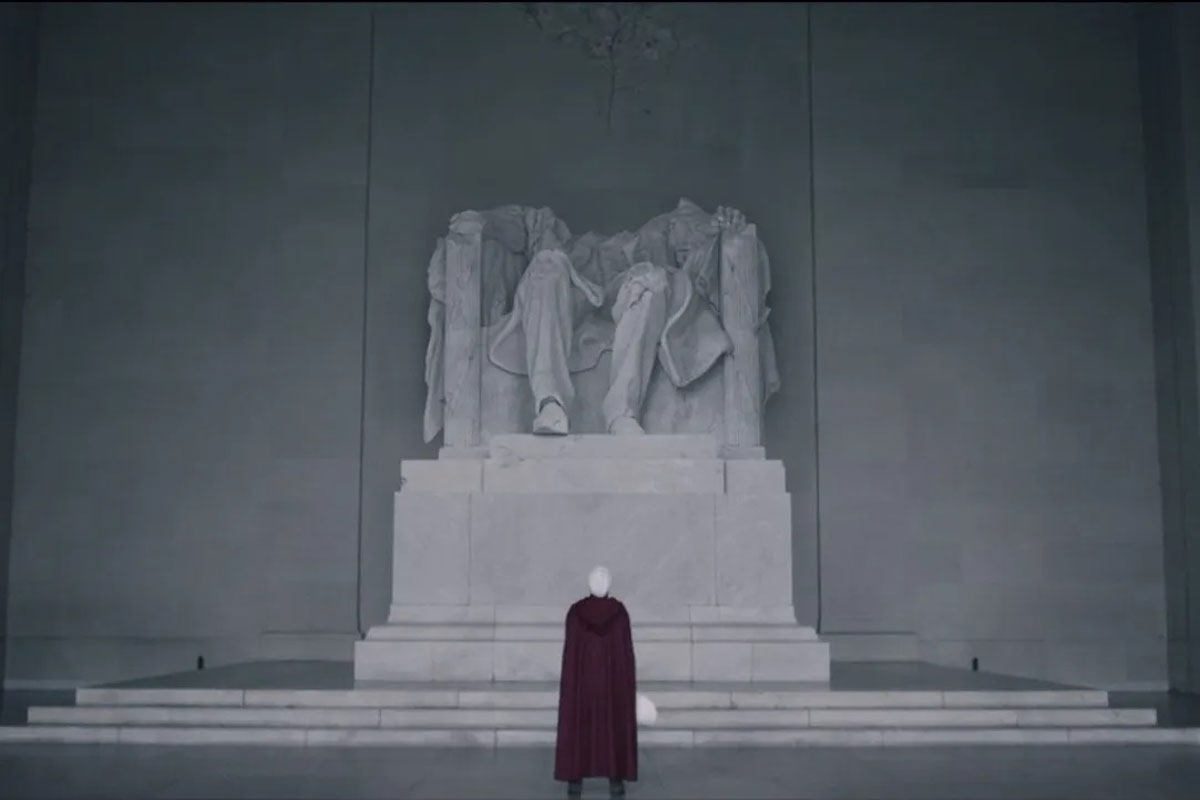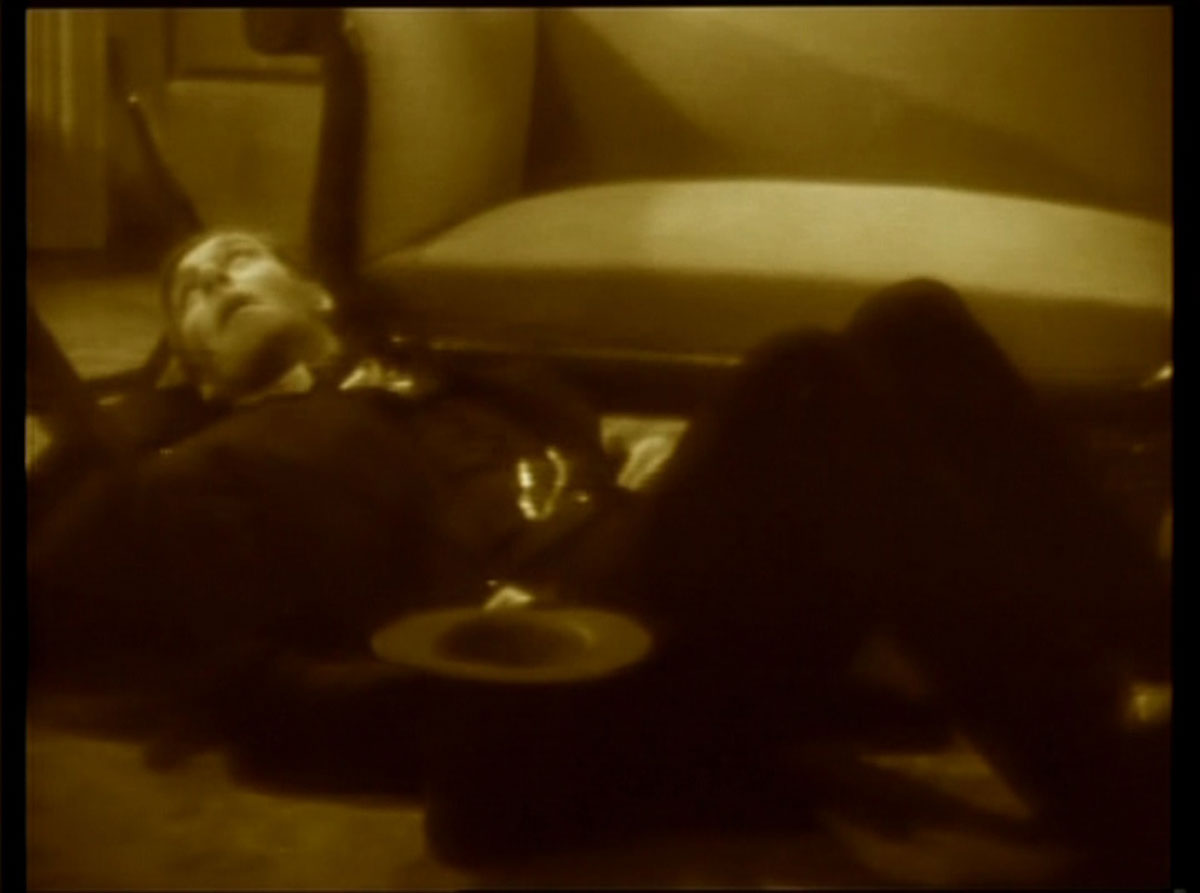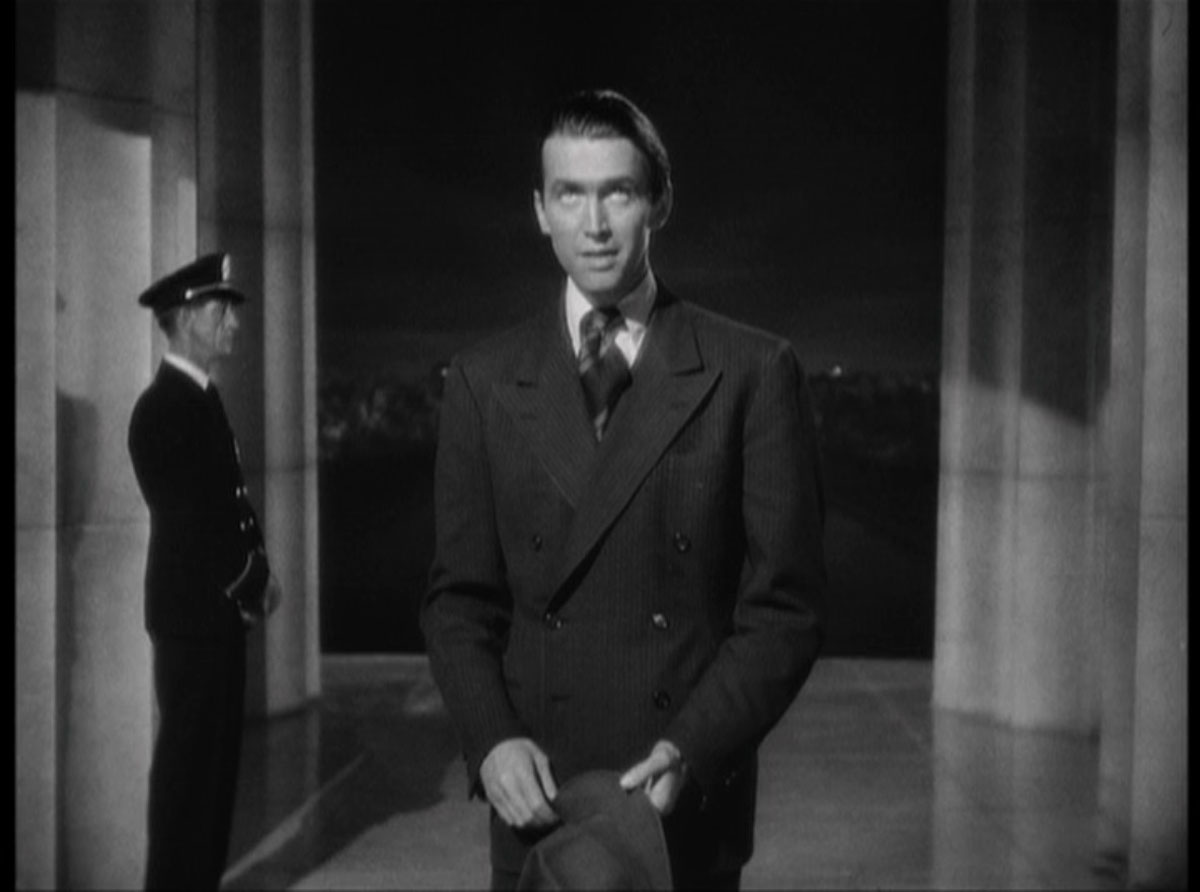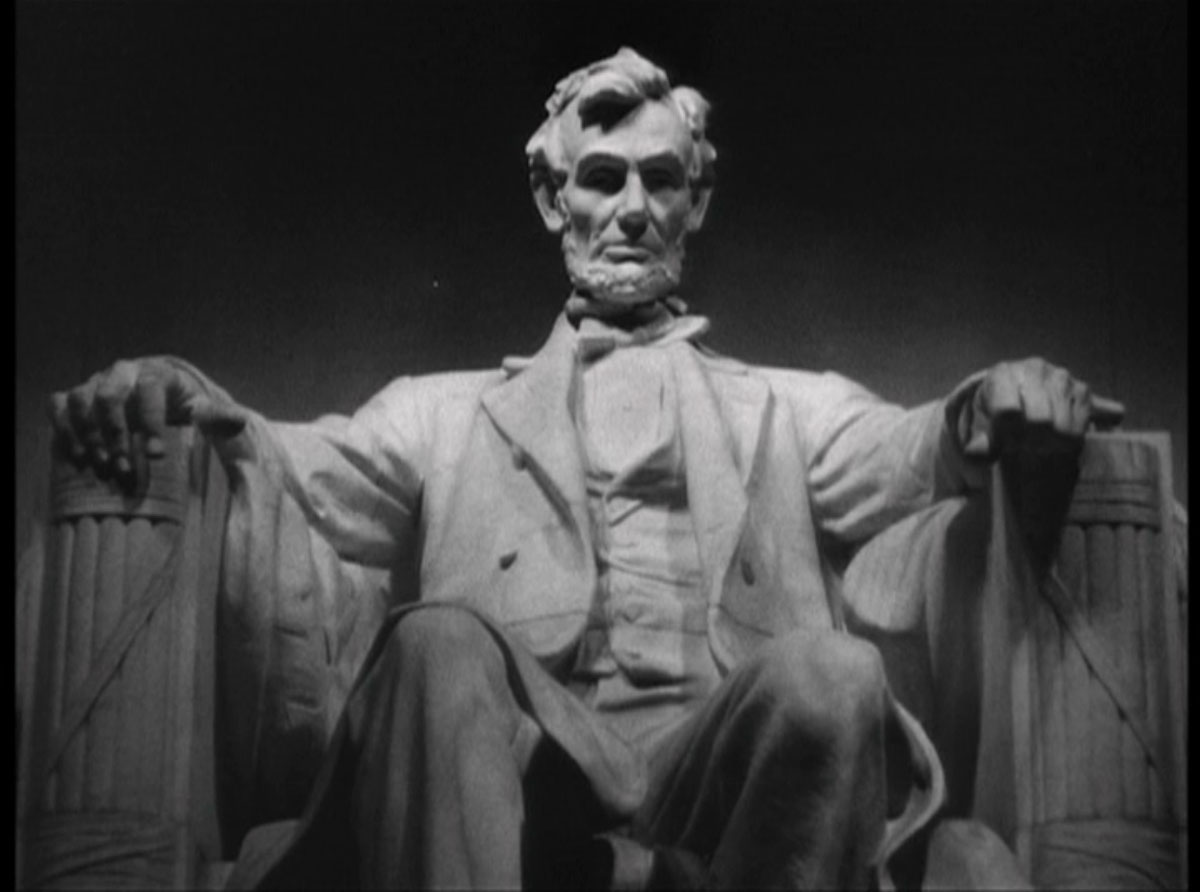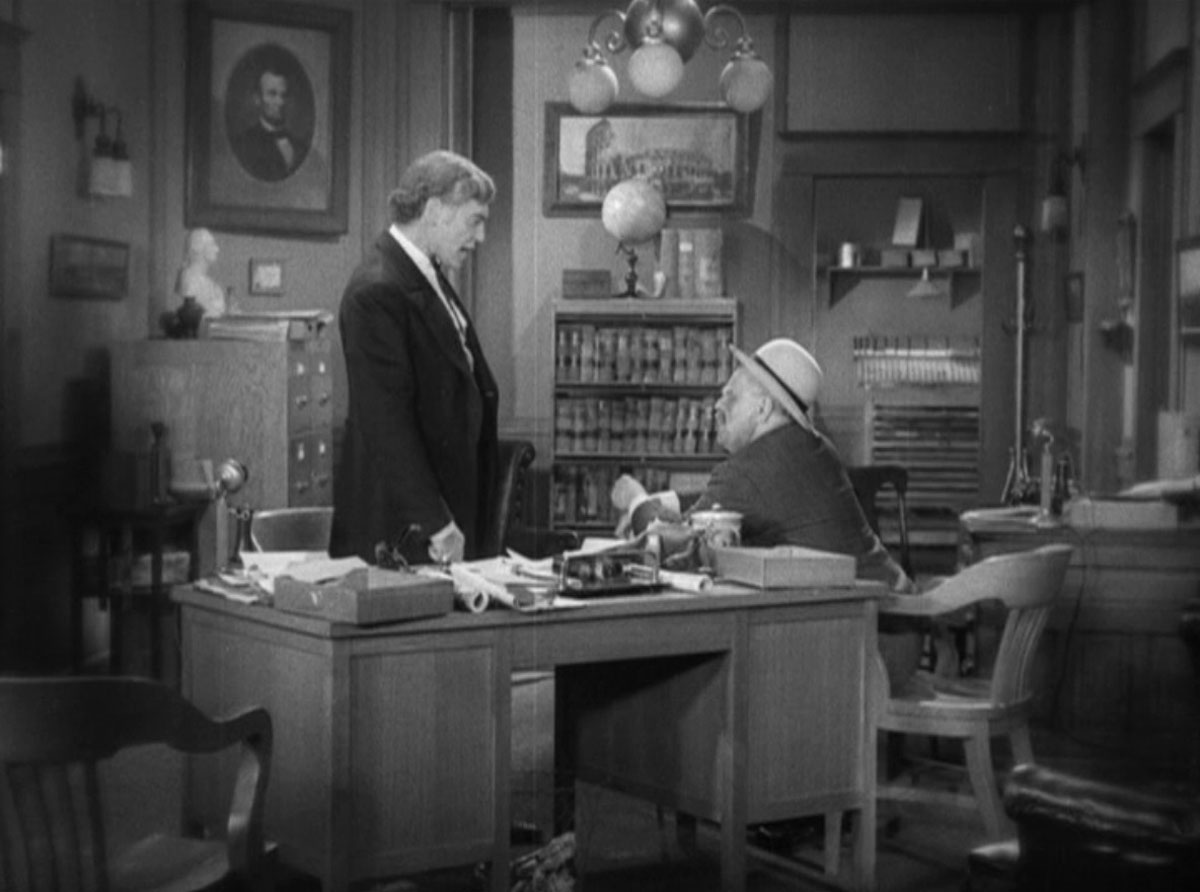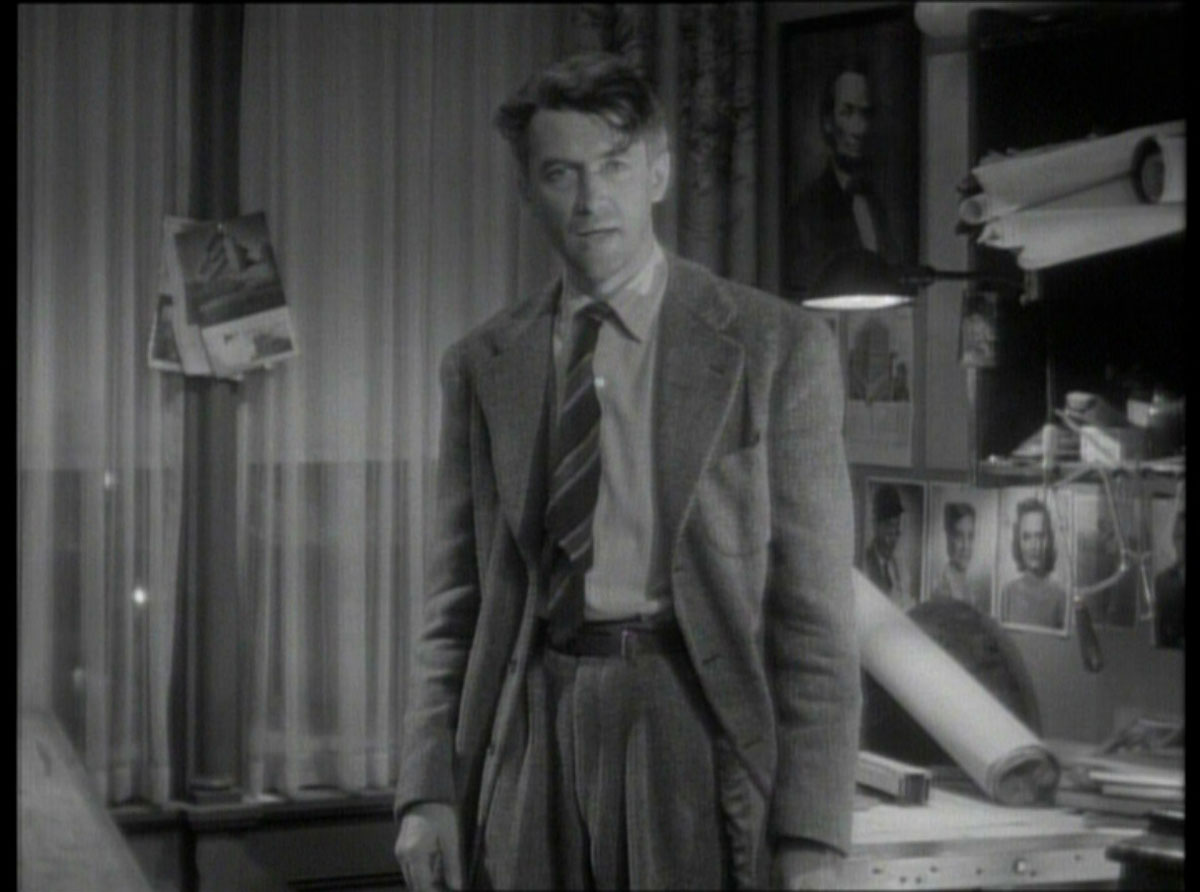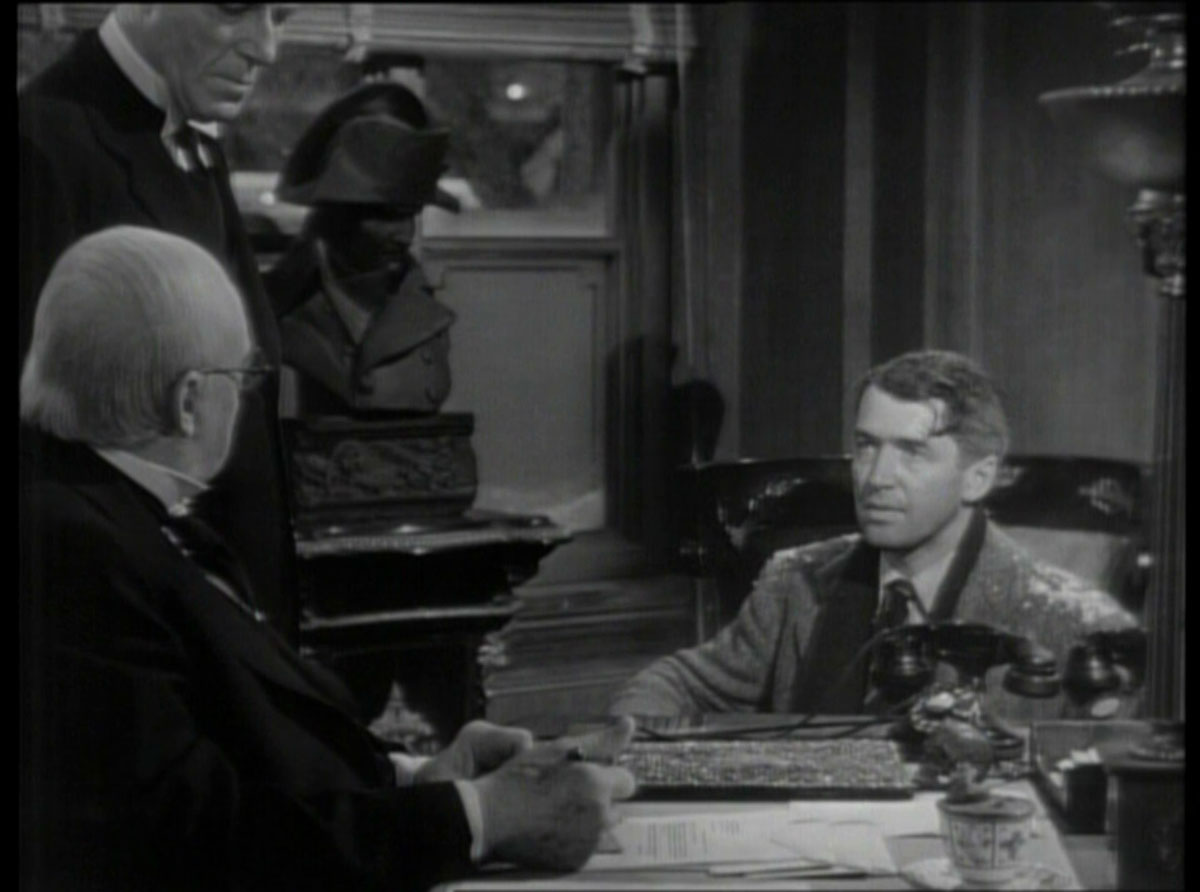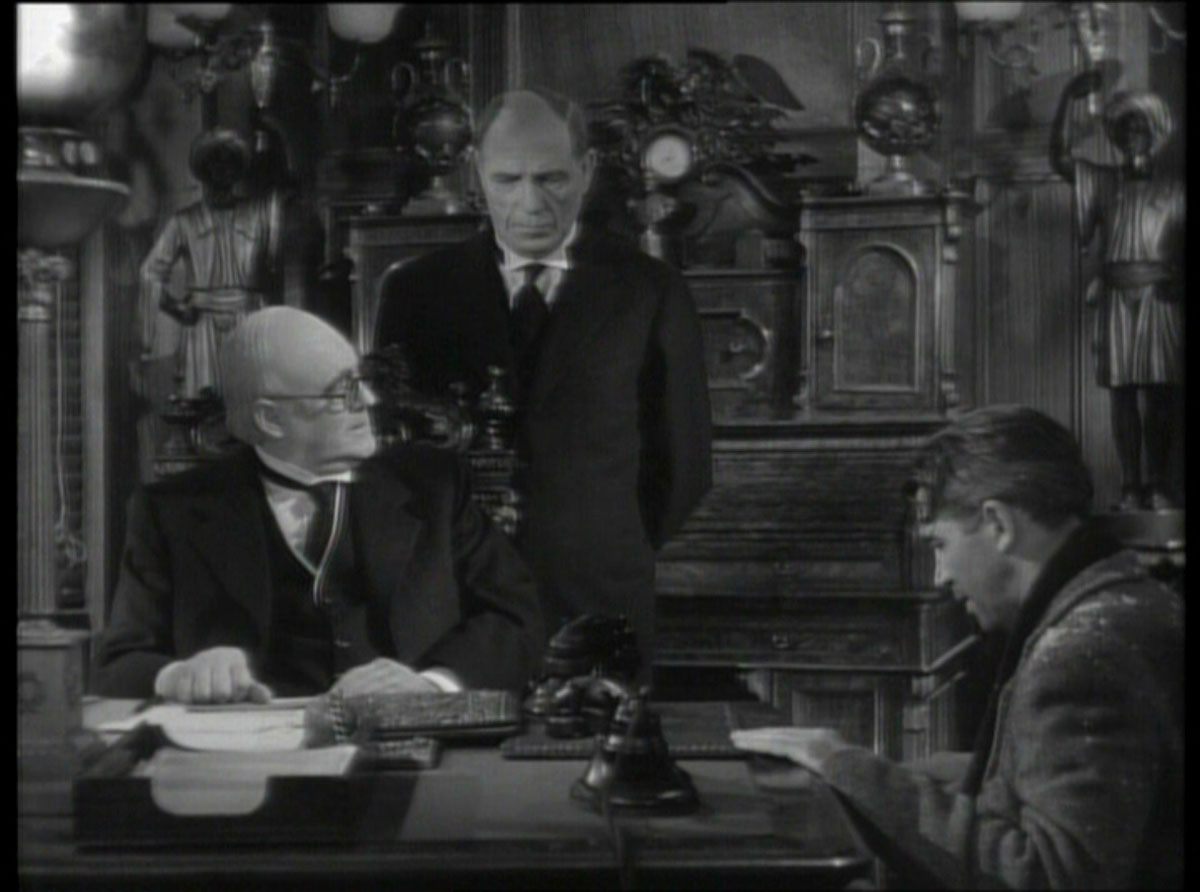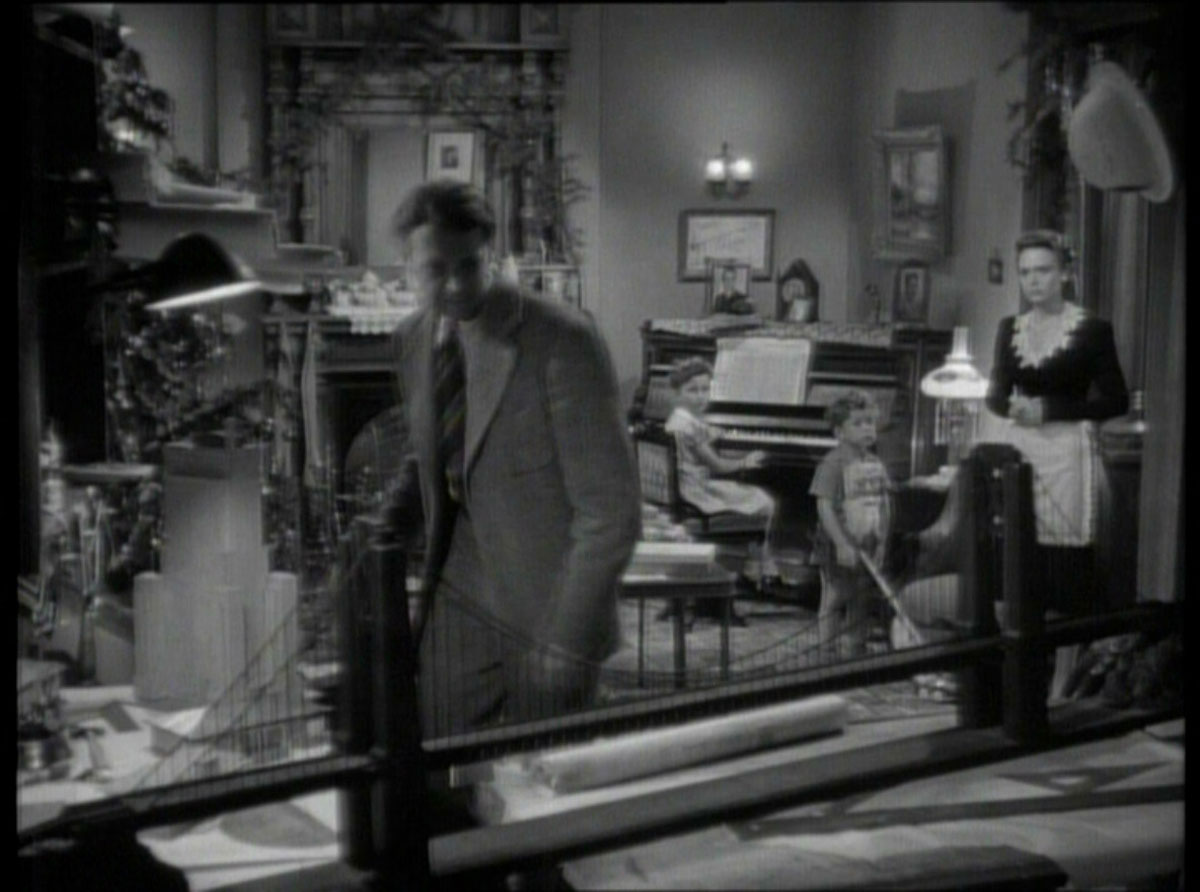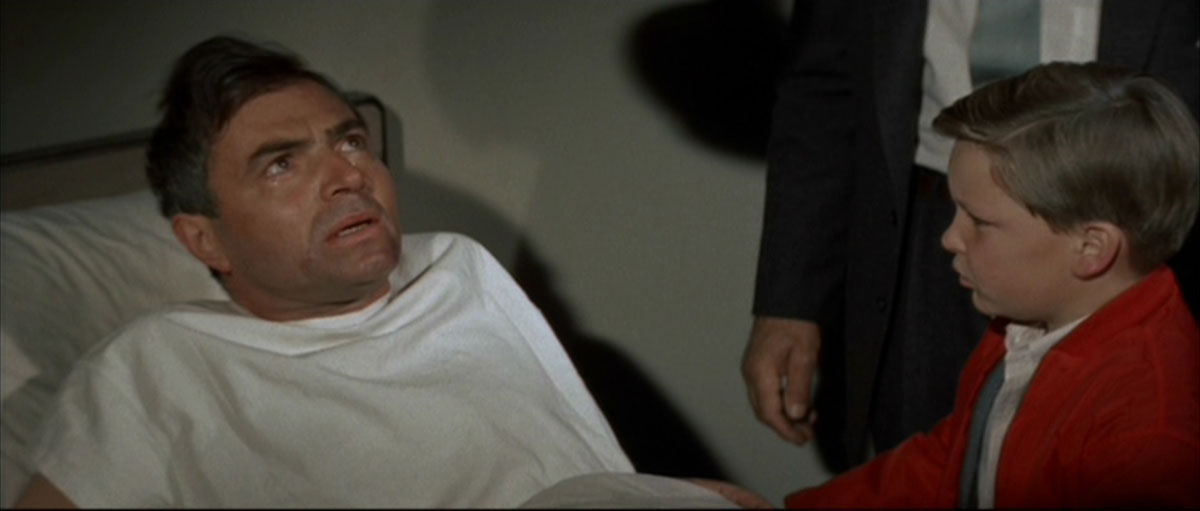This article considers a figure of such magnitude for American culture and its cinema that, ironically, it is important that we look at him indirectly, as well as directly. It will consider both flesh and blood incarnations of the sixteenth president, as well as ‘mere’ verbal and visual allusions. ‘Abraham Lincoln’ is tied to specific historical markers (Civil War, Emancipation, Assassination etc.) but also often acts as a Christ-like ‘transhistorical’ figure in the Hollywood cinema (Schleier 2014: 452), or as a ‘floating signifier’, ready to be attached to a certain set of American ideals that hold sway at any given moment and/or in any given production context. This is felt most strongly in his principal signification as ‘preserver of the Union’ at certain periods (emphasising a white version of brotherhood) and ‘great emancipator’ at others (white paternalism but overseeing a contrastingly bi-racial version of brotherhood).1 Though it will be a frequent biproduct, the primary focus of this essay will not be why Lincoln is being used in this way at this point in film history. Rather, I shall focus on the cinematic uses of the Lincoln image. I am interested in the rhetorical employment of ‘Lincoln’ in ways that encompass the most literal to the most metaphorical/allusive. The essay therefore proceeds through sections that focus on, first, flesh and blood incarnations (considering the concrete, formal qualities of performance). Then it looks at the solidity and symbolic power of the Lincoln memorial (performance again but also editing and space), and finally considers the place of Lincoln imagery within the narrative and mise-en-scène of complex films that are very little about Lincoln himself.
The prominence of Lincoln in the American cinema has waxed and waned over the medium’s history, inevitably in broad accordance with wider cultural and political trends. At the time of writing (the early 2020s), we are in something of an extended Lincoln lull, perhaps because a recent presidency for many (and for many in Hollywood) likely evacuated the office of much of its stature. 2012, on the other hand, marked the high point of a very clear ‘Lincoln moment’, which arguably reflected the culturally felt optimism towards the early years of the Obama presidency (2009–2017). 2012 saw the release of the hugely successful Steven Spielberg-directed Lincoln, which emerged alongside a raft of other texts.2 That year also saw the release of Abraham Lincoln: Vampire Hunter (Timur Bekmambetov, 2012). The latter, though a commercial failure, was released into over 3,000 theatres in the US (Box Office Mojo 2012a). Bekmambetov’s film was based on a book that was first published in 2010, the year Robert Redford’s The Conspirator was released, a film focused on the trial of Mary Surratt, who was accused, amongst others, of aiding Lincoln’s assassin, John Wilkes Booth. Moreover, in 2013, the low-budget feature Saving Lincoln (Salvador Litvak) received a small theatrical release in the US. The above films are all centred on Lincoln or on events with him as locus (his death at Ford’s theatre, for example) but other kinds of film attest to the then resurgent prominence of the sixteenth president in the American cinema. For example, Lincoln is a key motif running through the big budget action movie, White House Down (Roland Emmerich, 2013). In that film, the memorial figures at the start of the film and in the final image, and a watch supposedly gifted by Mary Todd to Lincoln is kept close to the heart of (and catches a bullet for) the African American President Sawyer (Jamie Fox): ‘Good ol’ Abe took a second bullet for me’.3
The sheer volume of Lincoln representations during Obama’s first term in office, combining with the clear emphasis on racial politics within those representations, suggests a relatively clear cause and effect relationship between ‘US Politics’ and the politics of its film representations. But accounting for the relative scarcity of cinematic representations of Lincoln that coincides with Trumpism comes up against the obvious limitation of my account: that I’m not considering television. Indeed, perhaps the most emotive Lincolnian image from this phase of American cultural production comes from a television show and is an image of his violent erasure. The third season (episode 6, ‘Household’) of the dystopian drama, The Handmaid’s Tale (2017-) sees Elisabeth Moss’s character travel to a Washington DC whose major architecture has been transformed by the totalitarian Christian theocracy of Gilead. Dressed in the handmaid costume that became, in the real world, an iconic image of resistance to attacks on reproductive and other civil rights during the Trump administration, Offred/June sees what was the Lincoln memorial but which, Taliban-like, has been violently defiled [Figure 1]. Offred/June visibly mourns the desecration of this symbol of liberal America – if nothing else, her emotional reaction and the obvious politics of the programme as a whole imbue the monument with this meaning.4
However, television is a related but different space for producing images of Lincoln, and here I can simply note a long phase of Lincoln’s relative absence from US films (which may or may not be quite different to what was happening within broadcast television and streaming). Before the 2010s, there had not been a cinema release of a film in which the historical Lincoln played a major role since Bill and Ted’s Excellent Adventure (Stephen Herek) in 1989 and no bona fide biopic since 1940’s Abe Lincoln in Illinois (John Cromwell). The latter came at the end of what has been called the ‘decade of Lincoln’ (Cameron quoted in Krukones 2003: 144), the 1930s seeing the release of two other biopics (Abraham Lincoln, D.W. Griffith, 1930 and Young Mr. Lincoln, John Ford, 1939), not to mention at least three feature films in which Lincoln plays a prominent role (The Littlest Rebel, David Butler, 1935, The Plainsman, Cecil B. DeMille, 1936 and The Prisoner of Shark Island, John Ford, 1936).
In considering Lincoln as a particularly resonant American metaphor in ways dependent upon but to some extent transcendent of his status as a real historical statesman, I give weight to films in which Lincoln is only alluded to as to films in which a performer incarnates him onscreen. Indeed, the third section is largely focused on films that have been much written about – It’s a Wonderful Life (Frank Capra, 1946) and Bigger than Life (Nicholas Ray, 1956) – but hardly at all from the point of view of Lincoln representations. The latter fact is scarcely surprising given that, in the first film, Abraham Lincoln’s portrait is only seen in the background of one scene and, in the second, Lincoln is only briefly invoked in dialogue and gesture. I contend, however, that brief allusions and invocations of the figure in non-literal contexts are at least as revealing of signifying weight as are the films that focus on his life directly.
I will work through three categories that denote core aspects of his cinematic persona: first the peculiar physicality that many actors have incarnated in surprisingly consistent ways; his physical vigour contrasts, to some extent, with my second category – that is a fortitude that is presented as unyielding; I will then consider the force of his vision (foresight, moral righteousness etc.) that can be called upon in a wide variety of narrative contexts and be used to add further texture to the dramatic concerns of specific films. The structure sees us move from the more concrete through to the more metaphoric and, therefore, greater prominence is given to representations of the real, physical figure over the opening half than in the second. My interest is primarily in the aesthetic and dramatic potential of the Lincoln figure but it is necessary, first, to locate him historically and with some reference to the always already mediated ‘real man’.
Physicality
Tyler: If you could fight anyone, who would you fight? … Any historical figure?
Jack: I’d fight Gandhi.
Tyler: Good answer!
Jack: How about you?
Tyler: Lincoln.
Jack: Lincoln?
Tyler: Big guy, big reach. Skinny guys fight till they’re burger.
Fight Club (David Fincher, 1999)
Lincoln was a famously tall man (6 foot 4 inches) and his legendary physical strength and vigour are often a feature of his film incarnations. It is, for example, knowingly called upon in Fight Club, it is clearly visible at the start of John Ford’s 1924 The Iron Horse (the extreme vigour of his handshake) and is a central conceit of Abraham Lincoln: Vampire Hunter. Amongst the legitimate biopics, Abraham Lincoln and Abe Lincoln in Illinois both stage the oft-cited story of the young Lincoln’s defeat of New Salem’s local bully, Jack Armstrong, almost identically. Young Mr. Lincoln, a freer biographical adaptation in this and most other respects, transplants the violent action to Springfield and substitutes the wrestling for Lincoln’s thwarting of a potential lynching both through his physicality (he kicks away a battering ram and challenges all comers to a fight) and broader implied sense of ‘castrating violence’ (to quote the Cahiers editors in their famous treatise on the film – Various 1972: 28). In this, all three show their debt to Carl Sandburg’s influential two-volume Abraham Lincoln: The Prairie Years ([1926]1955: 25), which recounts the Jack Armstrong anecdote. That said, the Griffith film’s ‘creative’ re-rendering of the incident gets repeated in all subsequent representations, which rather underlines the pre-eminence of previous cinematic representations, rather than, directly, literary sources, in determining how films represent the Lincoln figure.5
The scenes representing his physical prowess have at least two main functions: first they form part of the emphasis on Lincoln’s supposedly natural, earthy, unpretentious and authentically ‘American’ qualities, which are central to his image in the popular imagination. In the aforementioned scenes, Lincoln functions as something like the hero of a Western (in Abraham Lincoln and Abe Lincoln in Illinois, New Salem is a barely tamed, frontier-like town; in Young Mr. Lincoln, Springfield is more developed but remains pretty wild), though using physical strength rather than any skill with a gun. Melvyn Stokes has discussed the way the myth of the president’s ‘indigenous greatness’ developed in the popular consciousness (2007: 47) and the interaction with Western tropes conveys this in cinematic terms. In all three films, he embodies in a single figure the values that would be represented by both Ransom Stoddard (frontier lawyer) and Tom Doniphon (frontier gunslinger) in Ford’s 1962 The Man Who Shot Liberty Valance, thereby transcending the potential contradictions between them.6 The second major function, in stressing strength for strength’s sake, is to implicitly celebrate vigorous leadership – Lincoln rises to greater prominence in his local community due to these acts – adding to the sense that Lincoln had particular resonance for the American public against the backdrop of Franklin Roosevelt’s powerful executive response to the Great Depression. (Griffith’s Lincoln precedes FDR’s presidency but most of the representations during ‘the decade of Lincoln’ are concurrent with it).
The screen Lincoln’s physicality is less conventional in other respects. At either end of the 1930s, both Griffith and Cromwell show Lincoln ungainly stretched out on the floor – in Abe Lincoln in Illinois, this is how we are introduced to the rangy Massey/Lincoln and a striking moment in Griffith’s film sees the newly installed president exasperate the first lady by lying on the White House floor and using an up-turned chair as a head rest [Figure 2]. Young Mr. Lincoln offers a particularly self-conscious take on the cinematic Lincoln’s peculiar physicality. Though it is debatable the extent to which Fonda and the other filmmakers’ interpretation of Lincoln is ‘mythic’ or ‘monumental’ (see Smyth 2003 and Brown 2016: 236–248), the star’s highly deliberate performance alternates between relative mobility and stiff movements that become especially restricted when wearing the iconic stovepipe. Though in this case not wearing his hat, the scene of the dance where Mary Todd’s pursuit of the future president begins is typically Fordian (see also the dance scene in My Darling Clementine, 1946) and has Fonda’s Lincoln move in so stiff and ungainly a way it is as if a statue had got up and danced around the room: his head barely ever moves from its fixed, forward-facing position (nor generally does the upper half of his body) and his black costume, centrally framed against a largely white space, gives him the aspect of a two-dimensional image come to sentient life. Fonda’s highly controlled performance in the film achieves an extraordinary balance in giving life to a figure who feels to be both of flesh and blood and thus firmly embedded within the specific narrative world (he and Mary Todd share a joke about his wanting to dance in ‘the worst way’) and of mythic, literally monumental dimensions.
Lincoln is a bad dancer and clumsy with the opposite sex. He also often stoops in his screen representations. Of course, the real man was tall, and he would have been required frequently to bend down. However, the posture is consistent with other crucial aspects of his on-screen character: his humility and personability (bringing himself down to the level of others). The stooping also regularly conveys a man with so much on his shoulders. For example, the costume designer on the Spielberg-directed biopic, Joanna Johnston, talks on one of the film’s DVD extras about how the Daniel Day Lewis Lincoln clothing was made to have a ‘hanging’ quality – hanging downwards from his stooped shoulders in order to connote ‘the weight of the position he’s in’ (‘Crafting the Past’ on the 2013 DVD release).
Many of the physical peculiarities stressed in the above examples illustrate something that is key to many of the representations – that is that Lincoln is not an easy fit for the presidency. This is counterintuitive because of Lincoln’s centrality in the pantheon of Greatest American Presidents. However, his partial discomfiture in the role, which is manifest in the physical performance of all major screen Lincolns, is a marker of his superior moral quality. Not only does he often seem to literally bear the weight of the Union on his shoulders (from the stooped posture and heavy make-up emphasising the cavernous, care-worn eyes of Joseph Henabery in Griffith’s 1915 The Birth of a Nation to 2012’s Daniel Day Lewis) but his greater authenticity is evinced by, for example, his lying on the floor, which contrasts with the bearing of his perhaps too professional Washington peers. Lincoln’s not-too-comfortable fit with political life ties to a key characteristic of the 1930s representations – that is that he is also shown as impelled, reluctantly, by other people and by fate, towards elected office:
One of the most glaring inaccuracies is the portrayal of Lincoln as a man without political ambition. In fact, Lincoln had vast electioneering skills and great drive, which one would need to arrive at the presidency, and his law partner, William Herndon, referred to Lincoln as “a little engine of ambition that knew no rest.” (Krukones 2003: 149)
Lincoln’s fictional lack of ambition had a moral purity that one presumes resonated with American spectators who, already in the 1930s it seems, were cynical about their politicians and understood them to be defined precisely by their ambition – see Mr Smith Goes to Washington (Frank Capra, 1939) for the clearest illustration of the purity of the Lincoln image as a point of contrast to politics ‘as they really are’. Moreover, the screen Lincoln could rise above the toxic politics of mid-19th century America because he was, physically, above it. Sometimes the effort involved in bringing himself down to the level of political reality is visibly played out on his body.
Fortitude
‘… That Lincoln memorial! Geewhiz! Mr Lincoln, there he is! He’s just looking right straight at you as you come up those steps. Just sitting there like he was waiting for somebody to come along.’
Jefferson Smith, Mr Smith Goes to Washington
As the above section suggested, the physical has an unsurprisingly moral basis in these filmic representations. In considering what Lincoln represents in terms of ‘fortitude’, we shall continue along similar lines. Fortitude generally implies moral strength above all but I want to take the solidity that term implies quite literally because many films render it so. I will focus now mainly on the role of the Lincoln Memorial, the permanence of which acts as an apt memorialising metaphor for a man who is celebrated for remarkable endurance in his fight to preserve the Union. ‘Fortitude’ thus marks a shift in emphasis from the previous section that showed that the living Lincoln, however ‘monumental’ in spirit, often possesses a physicality that strains against the material constraints of his duties. In contrast, the seated Lincoln of the Washington monument is fixed, stable and serene.
Along with the White House, the Washington Monument and the Capitol Dome, the Lincoln Memorial is one of the most recognisable landmarks of the US capital and arguably the most emotionally charged in its cinematic representations. From providing only a relatively incidental backdrop (the exterior structure in, for example, the villain’s sinister appearance in Hitchcock’s Strangers on a Train, 1951) to the actual statue being used to reflect a sci-fi dystopia of America/Earth (indivisible) conquered (for example, the end of Tim Burton’s 2001 Planet of the Apes and the villainous Megatron’s occupation of Lincoln’s seat in Transformers: Dark of the Moon, Michael Bay, 2011), the memorial is often used in the cinema for its scale and ability to dwarf the individual human figure. This dwarfing often has a moral dimension. For example, in The Firm (Sydney Pollack, 1993), Tom Cruise’s compromised lawyer is pressured by the FBI to testify against his mob-affiliated employers in the memorial’s environs. The agent’s suggestion that he ‘wander back by that memorial’ is clearly in hope that this will help him do the right thing. Something similar is played out to comic effect in Team America: World Police (Trey Parker, 2004) where a montage of ‘hot shot actor’ Gary Johnston’s dilemma of whether to fight for his country sees the tiny puppet fixed and immobile and suitably awed (to the extent that a puppet can be said to be ‘awed’ – see Clayton 2010) in front of the statue. A differently ironic effect ensues in the scene in Oliver Stone’s 1995 Nixon (recreating an actual event) where the thirty-seventh president, meeting a group of anti-Vietnam war protesters camped out in the memorial, draws links between his and Lincoln’s presidency. Performance (the reactions of the protesters particularly) and the extreme low-angle that exaggerates the statue’s towering over Nixon makes the desperation of the comparison all too clear.
Perhaps the most famous cinematic use of the memorial is in Mr Smith Goes to Washington. We see Smith (James Stewart) visit the memorial twice, the first time coming very soon after the titular hero’s arrival in DC. Here, the memorial appears at the end of a sequence that conveys Smith’s bus tour around the capital. It is the only place lingered upon and its visit culminates a change of tone and a shift in scoring to a more elegiac register. Though the moment’s rhetoric is less bombast than the Slavko Vorkapich-created montage sequence that precedes it (which trumpets the landmarks of America’s democratic heritage), it is obvious nonetheless: a long-shot of Smith walking into the space in front of the statue and looking up to the seated figure stresses the latter’s enormity; shots of Lincoln’s face are intercut with close-ups of the president’s famous words engraved on the walls, all organised around Smith’s point of view; a young boy stands with (we presume) his grandfather reading the Gettysburg address; two shots of an elderly black man looking up at Lincoln are shown, one coinciding pointedly with the boy and grandfather’s reading out of the word ‘freedom’. Lincoln’s aura is here unambiguously saintly. The meaning of ‘Lincoln’ remains constant throughout the film (indeed, cinema’s Lincoln is often ultimately saintly even if other aspects of his signification float). However, the tone of the allusions to the sixteenth president take on further hues in other moments.
At the rally celebrating Jefferson Smith’s appointment as senator, portraits of both George Washington and Abraham Lincoln have a prominent place in the hall, but the latter is the only picture visible repeatedly – in certain shots, it looks as if the pictured Lincoln is with the rest of his audience in looking expectantly towards Mr Smith. The latter is, at various points, connected to Lincoln through the dialogue of other characters. Indeed, Capra himself stated that the film was ‘anchored in Lincoln. Our Jefferson Smith would be a young Abe Lincoln, tailored to the rail-splitter’s simplicity, compassion, ideals, humor and moral courage under pressure’ (quoted in Schleier 2014: 454). For example, before we have even seen him, Senator Paine (Claude Rains) refers to Smith as the ‘young patriot [who] recites Lincoln and Jefferson.’ Once in Washington, Smith visits Paine and there sees the senator’s daughter, Susan (Astrid Allwyn). He is so bumbling faced with the confident and beautiful young woman that he quite embarrasses himself (repeatedly dropping his hat and falling and knocking over an expensive lamp) and the father announces to his daughter once Smith has left, ‘Susan, you’ve made another conquest’. She responds wryly, ‘Not old honest Abe!’ Paine responds, ‘And with honest Abe’s ideals. A rare man these days, Susan’, not for the first time, guilt and concern hinted at in Paine’s delivery (Paine is part of a corrupt political machine that is using Smith as a dupe). There are resonances with the real historical Lincoln beyond the overt verbal allusion – i.e. Stewart’s lanky physicality echoes the physical manifestation of the awkwardness with women conveyed by many of the Lincoln incarnations, resonances combining here with the pratfall logic of screwball comedy.7
Smith’s second on-screen visit to the monument has a very different tone to the optimism of the first ‘meeting’. Despondent at the political corruption now revealed to him, Smith reads the final words of the Gettysburg Address engraved on the memorial’s interior walls, oppressive strings sounding on the score: ‘… government of the people by the people for the people…’ His mouth slightly slack, Smith turns slowly to face forwards, a slight shrug conveying alienation from the heroic words he had previously accepted wholeheartedly. Smith’s dejection is evident in his gaze, which is slightly downcast, and, when he looks up to the statue he so admires, he raises his eyes but does not tilt his head in a manner that would suggest comfort in meeting the monument’s gaze. A shot to the seated statue looking downwards creates an eyeline match and thus gives something like life to the marble figure. Stewart’s performance, a sheepish look upwards towards Lincoln, combined with strong emphasis on the score, evokes a schoolboy looking up at a feared and/or respected headmaster [Figures 3 & 4]. What precisely Smith feels (for he knows himself to be innocent) is unclear but, echoing as it does Paine’s discomfort under Smith’s gaze in the previous scene, Smith appears to feel shamed by the great figure’s glare. His feelings become clearer after he has left the bright light of the interior of the monument (an absence of visible light sources makes it seem as if it is the statue that shines) and takes a position between the pillars outside. Here Clarissa (Jean Arthur) tasks herself with rousing him, aligning Lincoln with the quality of fortitude, as well as many of the other characteristics (such as ‘indigenous’, unpretentious and uncorrupted common sense8) that we have touched on so far:
You had faith in something bigger… You had plain, decent, everyday, common rightness. And this country could use some of that…. Remember the first day you got here? Remember what you said about Mr. Lincoln? You said he was sitting up there waiting for someone to come along? You were right! He was waiting for a man who could see his job and sail into it, that’s what he was waiting for. A man who could tear into the Taylors and root them out into the open. I think he was waiting for you Jeff. He knows you can do it. So do I!
The pep talk has its desired effect. The stage is set for a now resolute Smith to enact Clarissa’s plan to use a filibuster but, before leaving with her, he turns and waves at the statue. This time accompanied by scoring that references ‘The Battle Hymn of the Republic’, the vision of the seated statue offers a gaze that is no longer accusatory. It is striking that the Lincoln Memorial, as the central reference point for fortitude and moral right, should be the last thing seen before the famous sequence of the filibuster. There, should Smith for a moment sit as he address the senate, he would yield the floor and the plan to defend himself and expose the corrupt machine of Jim Taylor would be lost – standing, not sitting like Lincoln, becomes an index of Smith’s moral worth and strength, but both signify fortitude (moral and/as physical), and a refusal to yield.9
The memorial in the scene above assumes meanings in a manner very approximate to the supposed Kuleshov effect. This is only possible because the face of the statue offers a relatively impassive expression onto which one might project a certain range of emotions, but also possesses the clear and ‘confident’ eyeline standard for statues of a Great Male Statesman. The cinematic possibilities of the statue here connect with broader cultural and historical uses of the monument. Merrill Schleier, drawing upon the work of Barry Schwartz’s Abraham Lincoln and the Forge of National Memory (2000), writes in relation to Smith’s gaze at the monument:
[Schwartz] refers to this process of regarding the president as both “a mirror and a lamp” especially during the Depression; that is, people saw in his commonplace roots and tribulations an analogue to their own and the country’s; at the same time, they regarded him as a transfigurative figure of religious proportions, akin to one of the immortals.’ (2014: 459)
While characters like Jefferson Smith might look to Lincoln as a source of guidance and a mirror of their own travails, so filmmakers have frequently called upon the memorial, particularly its statue, in order to mirror or reflect key dramatic, political or quasi-political concerns. Schleier’s mention of the monument as ‘lamp’ and allusion to transfiguration refers to the monument’s luminescence in the scene described above. However differently filmmakers might use the monument, in its design and in its construction, it is fixed point of reference, Christ-like in its embodiment as a ‘transhistorical’ (Schleier 2014: 452) guiding light of endurance, fortitude and moral rightness.
Vision
‘I was dreaming. I walked with Lincoln. He was as big and ugly and beautiful as he was in life’.
Ed Avery, Bigger Than Life
Abraham Lincoln is the foremost man of vision in American historical cinema and a particularly privileged holder of ‘the historical gaze’ – this is a performative gesture that, to some extent, suggests the character foresees what is to come (see Brown 2008: 163–167; Brown 2016). In this context, a gaze into the distance is frequently a marker of the president’s tremendous historical agency (as a Great Man Ahead of His Time) and apparently innate knowledge of the righteousness and ultimate triumph of his cause (i.e. the preservation of the Union and/or the abolition of the slave trade, depending on the emphasis of the film). The rhetoric of his historical foresight is at its heaviest in two relatively early Lincoln films, The Iron Horse and Griffith’s Abraham Lincoln. In the former, following multiple dedications to the sixteenth president that explicitly stress his vision, Lincoln appears in the opening scenes as a figure with the moral and historical weight to vindicate the aspirations of the surveyor, Brandon (George O’Brien), to lay a railroad and help tame the Western frontiers. One of Brandon’s neighbours says, ‘Poor dreamer – he’s chasing a rainbow!’ and the (youngish) pre-presidential Lincoln (played by Charles Edward Bull) responds, ‘Yes, Tom – and some day men like you will be laying rails along that rainbow.’ This is exactly what comes to pass: Tom becomes a railway magnate constructing a railroad along the route first plotted by Brandon and his son. The film is even more rhetorically explicit in a later intertitle as Lincoln signs a presidential decree: ‘The far-seeing wisdom of the great rail-splitter President is the beginning of the Empire of the West’ [emphasis added]. In Griffith’s biopic, where such portentousness has been absorbed into the early-talkie era dialogue, Walter Huston’s Lincoln frequently intones ‘The Union must be preserved’ as he gazes gravely off into the distance. In this section of the essay, however, I will be particularly interested in the way Lincoln’s ‘far-seeing wisdom’ can be embedded into the dramas of films beyond the explicitly historical. This not only underlines the extent to which Lincoln’s vision is celebrated in the American popular consciousness (as manifest in its film productions) but that an understanding of this vision is so deeply embedded that it is available to act as a metaphor in a variety of contexts and to be inflected in subtly different ways. This ties with and extends Tom Gunning’s argument (2015: 55–71) that Lincoln’s martyrdom helped the symbolism of Lincoln to be absorbed into the more literal cinema of sound’s first decade. While being cautious about making any simplistic film historical claims in this regard, this section shall encompass films that range from early-30s relative literalism to increasingly symbolic uses of Lincoln in, for example, a mid-50s melodrama.
Cimarron (Wesley Ruggles, 1931) is a little-known Western (of a kind) but one that has been celebrated for the sophistication and progressiveness of its approach to the legacies of frontier settlement (Smyth 2003a). The hero, Yancey Cravat (Richard Dix), is a complex and sometimes contradictory figure but, for the most part, one who represents liberal and humane values resistant to the exploitation and oppression of the Native Americans whose land is stolen in the Oklahoma land rush. Yancey founds a campaigning newspaper and has aspirations to the office of governor. At one point, while sitting at his desk, writing a radical editorial, he is visited by powerful, corrupt local businessman, Pat Leary (Robert McKenzie). Leary offers to aid Yancey’s election if he agrees to turn a blind eye to Leary’s swindling of the Indians. Indignant, Yancey stands and declares his opposition to ‘The dirtiest, filthiest bit of politics that ever came into the state of Oklahoma,’ a framed portrait of Abraham Lincoln behind him. [Figure 5] It is as if Yancey were joined by Lincoln in looking down on Leary and condemning all he represents. Leary storms out and vows to smash Cravat’s hopes at election. That Yancey is on some level allied with Lincoln in terms of political righteousness is evident but one might also stress the link in terms of the far sightedness of his vision. In this, he is contrasted with his wife, Sabra (Irene Dunne), who is primarily concerned with petty issues of her present – i.e. enforcing a strict moral code and rigid hierarchy atop which she and her female society friends sit. In the moment just after leary has stormed out, Yancey and Sabra argue and she threatens never to forgive him if he publishes an editorial admonishing the government for its swindling of the Indians and calling for their full citizenship and enfranchisement. He tells her, ‘Oh yes you will, Sugar. “Never” is a long time. Someday you’ll be able to turn back to the old files and read this article and be proud it was printed.’ The film’s final section flashes forward to 1929 where many of Yancey’s predictions and wishes have come true, including Sabra’s pride in the radical legacy of the paper she now edits. Yancey is thus compared – if only subconsciously – to the patriarchal discourse of Lincoln’s far-sightedness.
Lincoln’s portrait is called upon for more overt rhetorical ends in Juarez (William Dieterle, 1939), appearing over the shoulder of the titular Mexican statesman (Paul Muni) in more than one scene, and acting in the script as a recurrent touchstone for his democratic idealism. John Ford who, with Capra, was one of the most persistent and interesting users of the Lincoln image and/or idea, has characters in both The Man Who Shot Liberty Valance and Cheyenne Autumn (1964) positioned by Lincoln portraits in ways that index their relationship to themes of racial (in)justice: Pompey (African-American actor Woody Strode) discusses the Declaration of independence and the phrase ‘all men are created equal’ with Lincoln over his shoulder; the Secretary of the State for the Interior (Edward G. Robinson) talks to a Lincoln portrait as he contemplates US mistreatment of the Cheyenne. In all these examples, the Lincoln picture is used in historical settings to align lead characters and the film’s overarching rhetoric with contemporaneous values à la the historical gaze. In the next two examples, recourse to Lincoln as a figure of vision is inflected very differently and, I would argue, shades into irony. In both, the Lincoln image is called upon to suggest, amongst other things, illusions of grandeur and the fact that the vision of the films’ heroes may extend too far.
The first example can be only touched upon due to its complexity (see especially Thomas 2001 and Wood 2003). Though not one of the Frank Capra films that actually name checks Lincoln (Mr Deeds Goes to Town, 1936, and Meet John Doe, 1941, along with Mr Smith Goes to Washington), this is the director’s most famous film: It’s a Wonderful Life. Here, there is only a single visual reference to Abraham Lincoln and that is (irony number one) in the scene where an embittered George Bailey (James Stewart again) rails at his family and makes his children cry – Lincoln is seen as the largest and highest portrait on the wall in the corner of the family living room that functions as George’s study/workshop. [Figure 6]. On the simplest of levels, George having a picture of Abraham Lincoln simply underlines that he is at essence ‘a good guy’. This is most baldly apparent if one contrasts his surroundings with those of the villainous Potter (Lionel Barrymore). In the cut to the scene immediately afterwards, as George visits Potter to ask for financial rescue, the latter’s bust of Napoleon seems to be glaring down at the hero. [Figure 7] Napoleon is approximately the opposite of Lincoln in the popular imagination: a supposedly short guy over-compensating for his physical stature; the ‘Napoleon Complex’; the hubris of Napoleon’s invasion of Russia Vs. ‘Old Honest Abe’; the latter often shown as the reluctant conqueror of the South, magnanimous in victory (Noon 2015: 39–54) and marked by a humility and personability that belied his huge physical stature.10 Potter’s contrasting desire for dominion is reflected in his character’s choice of décor – not only the bust of Napoleon but the two slave figurines that are visible in the background of another shot [Figure 8].
Potter’s study also contains a very large and ornately framed portrait of himself. His narcissism (our first view of him is in his crassly monographed carriage) can be taken to contrast with the humility and humanity evident in George surrounding himself with images of his family and his clear admiration for Lincoln. Perhaps. But then again, to place Potter and George at opposite ends of a spectrum would be to misunderstand the complexity of It’s a Wonderful Life (see Wood 2003: 66–67). There is hubris in George and this, if anything, is the ‘sin’ that the vision of a world without him punishes – this characterisation runs contrary to the stated aim of his guardian angel Clarence to show George what he and his life are worth (a great deal) but George’s loss of faith in the value of his life is precisely due to a desire for something else that borders on the hubristic. In one of the moments singled out by James Walters in his reading of the film (2008: 123), a young George and Mary make wishes by smashing the windows of the derelict house that will later become their home. After George’s rock has crashed through a pane on the second floor, Mary (Donna Reed) asks him what he wished for. He responds:
Well, not just one wish. A whole hatful, Mary. … I’m shaking the dust of this crummy little town off my feet and I’m going to see the world. Italy, Greece, the Parthenon, the Coliseum. Then I’m going to college and see what they know… and then I’m going to build things. I’m gonna build airfields. I’m gonna build skyscrapers a hundred stories high. I’m gonna build bridges a mile long… (emphasis in delivery)
George may be somewhat greedy in his wishes but his aspirations (to travel around Europe, then go to college to study engineering) are reasonable enough for a bright young man who has always been loving and dutiful to his family. The frustration of these ambitions will lead to latent bitterness and the tension between these masculine ambitions (to travel free and unfettered and to build very big things) and the entanglements of domestic life are there to see in the décor that includes Lincoln’s portrait. Indeed, at the high point of George’s anger in this scene, he shouts at this children and then smashes a model of a skyscraper and a bridge [Figure 9]. The shot immediately after this is where the former president’s portrait is first seen. It is clear that George has not abandoned his dreams towards engineering. However, there is something pathetic (in the original sense) about these models and what they represent being situated in the cramped corner of this family room long after an exuberant and juvenile George expressed the desire to ‘build skyscrapers a hundred stories high’ and ‘bridges a mile long’. George is in fact engaged in building work of real social import for Bedford Falls, but Bailey Park’s modest, affordable alternatives to Potter’s slums contrast with these models of huge constructions. The latter can be read as symptomatic of a man unwilling to let go of boyhood dreams and aspirations. Aren’t ‘architectural models’ of things one could never hope to build really just toys? Seen in this light, the portrait of Lincoln remains an indicator of George’s moral worth. However, it can also be seen as further evidence of the hero’s hubris. Might dreamer George be flattering himself and see himself as a bit like Lincoln? Might this be why he has the portrait on his wall? As I have suggested, Lincoln is the preeminent man of vision in American history as represented in its cinema. In The Iron Horse especially, he is also associated with the muscular history of the engineering of north and south, east and west. A final irony of his portrait’s inclusion in It’s a Wonderful Life may be that it further suggests that George Bailey’s vision is too concerned with the far off, the grandiose, the ‘if only’, which blinds him to the value of the more modest things he already possesses.
Hubris, strictly speaking, is more unambiguously at the narrative centre of the 1956 male melodrama, Bigger than Life. The narrative concerns a school teacher, Ed Avery (James Mason), who, suffering from a life-threatening illness, is prescribed the new wonder drug, Cortisone. Financial pressures lead to circumstances in which Ed alters his doses and suffers side effects that include delusions of grandeur. These become steadily more severe until he is in the grip of a fully-fledged psychosis that leads him, almost, to murder his young son.
Lincoln is one of the largest figures, literally and metaphorically, in the United States historical consciousness and the largeness of this image was crucial to my final reading of its use in It’s a Wonderful Life – i.e. perhaps underlining the ironic gap between George’s reality and his grandiose ideas of himself. This largeness of Lincoln’s image links to Bigger than Life and is crucial to the moment quoted from at the top of this section, where questions of vision (vision of oneself, visions of Lincoln) are also at play. The moment comes at a crucial stage in the build-up to the film’s (arguably ambivalent) happy ending (Thomas 2000: 41–42). Ed has been heavily sedated following the collapse that ended the psychotic episode where he attempted to kill his son, Richie (Christopher Olsen). The doctor invests the moment Ed will wake up from his drug-induced sleep with considerable tension. He tells the family Ed may wake up in a permanently psychotic state. Only ‘if he can remember everything that happened and face it’ will things be okay. As Ed wakes up, this tension is maintained through much of Ed’s dialogue with those at his bedside. ‘Turn out the sun’ are Ed’s first words, as the light above his bed dazzles him. He clarifies for the bemused doctors by saying ‘The overhead light, you fool’ but the initial strange choice of words (massively inflating the scale of what he sees) raises fears his psychosis still reigns. He looks around him and is confused and asks what has happened and where he is. He then looks squarely at the doctor and they have the following exchange:
Ed: I’m disappointed.
Doctor: About what?
You’re a pretty poor substitute for Abraham Lincoln.
How do you mean that?
You’re not! You’re not Abraham Lincoln, are you?
Cut-away shots to Ed’s wife and son as he compares (or confuses) the doctor with Lincoln convey their tension at this moment. However, a glint in his eye, if not a tongue in his check, suggests facetiousness. Ed becomes more clearly cognisant of what is around him and recognises his wife and son. This offers hope but suspense remains as he calls Richie over to him. Ed looks into the distance in front of him and declares, ‘I was dreaming. I walked with Lincoln’. The words seem to swell in his chest, conveying Ed’s enjoyment in the grandiosity of this dream. A cut to a closer position shows Ed (with Richie beside him) look upwards with moist eyes: ‘He was as big and ugly and beautiful as he was in life…. Abraham!’ [Figure 10] Lincoln seems to have been chosen by the dialogue writers for his magnitude which is, as usual, both literal and metaphoric: Ed’s performance suggests a small man or, as Deborah Thomas suggests, a child (2000: 41), looking up to the tall president or perhaps the monument that literalises Lincoln’s historical grandeur; ‘Big and ugly and beautiful’ also connote something like the sublime, which suggests enormity on a more metaphorical or metaphysical plane. Crucially, however, the reference to Lincoln functions, with the final repetition of his forename, to remind Ed of his psychosis and its nadir, which saw him take the biblical story of Abraham and Isaac to be an instruction to kill Richie. Given this key dramatic peak, the reference to the biblical Abraham may be taken to be preeminent. However, the rhyming reference to Lincoln is especially apt in so well-titled and intricately designed a film as Bigger than Life, and ‘Lincoln’ contributes to the film’s consistent interest in questions of magnitude and aggrandizement, the latter being more specifically a function of how one sees oneself and the world.
Concluding Remarks
Films such as It’s a Wonderful Life and Bigger Than Life underline the extent to which Lincoln functions in the Hollywood cinema (and American culture beyond it) as a floating signifier. The aptness of the sixteenth president’s image for each film lies partly in a rather vague sense of scale, importance, moral weight/significance – put simply, ‘bigness’. Indeed, though neither film’s title would ask to be read in any straightforward way, the shared mention of ‘life’ suggests that each proposes to make some broad statement about ordinary American existence (though the tone and subtlety of each film belie the grandiose aims this description would imply). It’s a Wonderful Life is precisely about how one values a relatively ordinary life (married with children; small-scale, community- rather than profit-oriented capitalism) in a relatively ordinary small town and measures it against other standards of masculine achievement (building huge bridges, being very rich and/or being a war hero – i.e. George’s brother); Bigger than Life invokes ‘life’ in a seemingly more straightforward way in alluding to the demented hubris of the hero, but the film also has much to say about everyday, conventional gender roles in suburban society that are to some extent separable from Ed’s medical condition (see again Thomas 2000: 29–42). The ‘life’ titles’ combination with the brief allusions to Lincoln are thus something more than coincidences, though the correspondence perhaps primarily underlines something relatively indistinct about his being a very ‘big’ figure in the American consciousness.11 But this hazy, metaphoric ‘bigness’ is itself worthy of note. We see evidence of the extent of his force as one of the US’s foremost men of vision. The adaptability of this idea of the sixteenth president means it can be used at various points along a sliding scale between literalness and metaphor. For example, in contrast to the ‘historical gaze’, which renders the force of Lincoln’s vision in often too concrete (if not leaden) ways, It’s a Wonderful Life and Bigger than Life demonstrate the subtler cinematic potential of an idea of vision that goes beyond everyday concerns, thereby, revealing the depth of Lincoln’s penetration into the American cultural imaginary.
The first sections of this essay showed the striking similarities in how Hollywood has represented Lincoln’s physicality. It is perhaps unsurprising that such a celebrated American statesman is shown to be big and strong but it is surprising how often he is shown to be awkward.12 The truth or otherwise of this physical characteristic is beside the point. What is observable is how various films make use of Lincoln’s physical awkwardness and make it a moral thing: in contrast to the upstanding, pompous bearing of other politicians, Lincoln is seen stooping (humility) or down on the ground (‘earthy’, authentic). This is a figure whose official monument, the Lincoln Memorial, came to stand for a certain ideal of the United States. Are there other historical figures who are venerated on such a vast and imposing scale, who can signify a ‘transhistorical’ vastness, and are used to convey so much at a humble and humane level too?
Notes
- Rommel-Ruiz (2003) is one of a number of discussions of the way 20th-century representations generally stressed ‘preserver of the union’ and sought to side-step the more contested field of racial politics. However, many, Staiger (2013) included, have noted the more recent turn towards ‘great emancipator’. Staiger’s essay appears in the ‘Lincoln and Ideology’ forum in issue 55 of the online Jump Cut. This forum is a particularly rich resource of 21st-century commentary on Abraham Lincoln representations. [^]
- On a relatively modest production budget of a reported 65 million dollars, the film grossed over 275 million worldwide (Box Office Mojo 2012). The film was also nominated in 12 Academy Award categories, winning in two. It is based on Doris Kearns Goodwin’s Team of Rivals: The Political Genius of Abraham Lincoln. The film tie-in version of this book (2013) has a gushing testimonial (“a wonderful book…”) by Obama at the top of its back page blurb. [^]
- Olympus has Fallen (Antoine Fuqua, 2013), a film and narrative of remarkable similarities to White House Down but of some political, or at least tonal, differences, has the hero beat one of the villains to death with a bust of Lincoln, which I take to be indicative of this more unpleasant film’s sense of humour – beating a foreign invader of the White House with Lincoln’s bust is both an assertion of American virility and also, arguably, a blankly ironic use of Lincoln’s frequent association with magnanimity and Christian forgiveness. [^]
- Since Martin Luther King Jr’s ‘I Have a Dream Speech’ (1963), the Memorial also carries more specific civil rights resonances, something drawn on by Spike Lee in Get on the Bus (1996). [^]
- The relevant scenes from all three films contain variations of the phrase ‘I’m the biggest buck o’ this lick!’ and also the challenge to come and ‘Wet your horns’ in a fight. These phrases come directly from Sandburg (1955: 15) but the latter does not locate them with the fight with Armstrong (1955: 25). The subsequent biopics therefore repeat the creative compression done by Griffith’s film, rather than return to the written source. The book on which Abraham Lincoln: Vampire Hunter is based (written by Seth Grahame-Smith, 2010), a creative though in some respects surprisingly ‘accurate’ response to standard Lincoln biography and chronology, follows the films in featuring the phrase ‘I’m the big buck of the lick’ in the Armstrong fight (128–131). [^]
- This analysis is developed in a videographic iteration of this research (Brown 2023; see especially the final third). This video essay will hopefully be forthcoming on a peer-reviewed platform/online publication but it is also hosted on YouTube: https://www.youtube.com/watch?v=i2YDDx_gqXI. [^]
- The theme of Lincoln’s awkwardness is also developed in the previously cited video essay (Brown 2023). [^]
- The real Lincoln’s ‘common sense’ is often invoked at some level in written or filmed accounts of him and it even provides one of the central lines of enquiry in a rather unusual biography of the man (Kempf 1965). [^]
- The resonances between the seated Lincoln statue and the filibuster as an act of ‘standing up for democracy’ were suggested to me by Edward Gallafent’s paper at the Screen Conference, University of Glasgow, 4 July 2010. [^]
- See also Bill and Ted’s Excellent Adventure, where both Lincoln and Napoleon are brought back to 1989 California. Comedy ensues from the transportation of both but Napoleon is the film’s main comic foil because, as Ted’s younger brother puts it so succinctly, ‘He was a dick.’ [^]
- A more specific issue there is not the space to discuss fully is the interest in fatherhood shared by both films and we might consider this in relation to Lincoln as, though not one of the ‘founding fathers’, one of the nation’s most important paternal figures who kept the states united. Lincoln’s portrait in George’s living room is next to pictures of loved ones (as well as pictures of big buildings) and, as Deborah Thomas has suggested, Ed looks up at Lincoln as if he were a young son looking up at a tall father. The patriarchal elements of Mr Smith Goes to Washington, and of the Lincoln Memorial, and of its role in Capra’s film, are a prominent focus of Merrill Schleier (2014). The paternal resonances of the Lincoln figure for fictional President Josiah Bartlett (Martin Sheen) from The West Wing (NBC, 1999–2006) are explored in Greg Frame’s excellent book on The American President in Film and Television (2014: 152–153; 165–167), in part via Charles Strozier’s (2001) work on Lincoln. [^]
- In no way undermining the value of what can be achieved in prose accounts of performance and representation, there is something unmatchable in actually seeing this awkwardness play out across film examples (see Brown 2023). [^]
Acknowledgements
Particular thanks must go to my mentor and colleague Ginette Vincendeau, who supervised the research that gave rise to my interest in the cinematic Lincoln, and who also read drafts of this work. The generosity of Ginette’s support to me and others seems to know no bounds. Also special thanks to my dear colleague Belén Vidal, who allowed me to present the work to students of her biopics module, and who also gave me feedback on draft work. I’d also like to thank the wonderfully supportive Mark Glancy who invited me to talk about Lincoln in two fora.
Competing Interests
The author has no competing interests to declare.
References
Box Office Mojo 2012 ‘Lincoln’. http://www.boxofficemojo.com/movies/?id=lincoln.htm [Last accessed 29 July 2023].
Box Office Mojo 2012a ‘Abraham Lincoln: Vampire’ Hunter’. http://www.boxofficemojo.com/movies/?id=abrahamlincolnvampirehunter.htm [Last accessed 29 July 2023].
Brown, Tom 2008 ‘Spectacle/Gender/History: the Case of Gone with the Wind’, Screen, 49: 2, 157–178. DOI: http://doi.org/10.1093/screen/hjn023
Brown, Tom 2016 Spectacle in ‘Classical’ Cinemas. Musicality and Historicity in the 1930s. New York: Routledge. DOI: http://doi.org/10.4324/9781315723136
Brown, Tom 2023 ‘Abraham Lincoln in the Hollywood Cinema’. https://www.youtube.com/watch?v=i2YDDx_gqXI [Last accessed 28 July 2023]. Critical Commons license: Abraham Lincoln in the Hollywood Cinema © 2023 by Tom Brown is licensed under CC BY-NC-ND 4.0
Clayton, Alex 2010 ‘Performance, With Strings Attached: Team America’s Snub to the Actor’ in Brown, Tom & James Walters (eds) Film Moments: Criticism, History, Theory. London: British Film Institute, 127–130. DOI: http://doi.org/10.1007/978-1-349-92455-4_28
Frame, Greg 2014 The American President in Film and Television: Myth, Politics and Representation. Oxford: Peter Lang. DOI: http://doi.org/10.3726/978-3-0353-0634-7
Goodwin, Doris Kearns 2013 Team of Rivals: The Political Genius of Abraham Lincoln. London: Penguin Books.
Grahame-Smith, Seth 2010 Abraham Lincoln Vampire Hunter. London: Corsair.
Gunning, Tom 2015 ‘Mr. Lincoln by Mr. Ford and Mr. Griffith: Image and History in American Cinema’ in Jeff Menne and Christian B. Long (eds) Film and the American Presidency. New York: Routledge, 55–71. DOI: http://doi.org/10.4324/9780203502051-4
Kempf, Edward J. 1965 Abraham Lincoln’s Philosophy of Common Sense. New York: New York Academy of Sciences.
Krukones, Michael G 2003 ‘Motion Picture Presidents of the 1930s: Factual and Fictional Leaders for a Time of Crisis’ in Rollins, Peter C. & John E. O’Connor (eds) Hollywood’s White House. The American Presidency in Film and History. Lexington: the University Press of Kentucky, 143–158.
Noon, David Hoogland 2015 ‘“So Typically Southern”: Abraham Lincoln, the New South, and the Romance of Reunion’ in Jeff Menne and Christian B. Long (eds) Film and the American Presidency. New York: Routledge, 39–54. DOI: http://doi.org/10.4324/9780203502051-3
Rommel-Ruiz, Bryan 2003 ‘Redeeming Lincoln, Redeeming the South: Representations of Abraham Lincoln in D.W. Griffith’s The Birth of a Nation (1915) and Historical Scholarship’ in Rollins, Peter C. & John E. O’Connor (eds.) 2003 Hollywood’s White House. The American Presidency in Film and History Hollywood’s White House. The American Presidency in Film and History Hollywood’s White House. The American Presidency in Film and History. Lexington: the University Press of Kentucky, 76–95.
Sandburg, Carl 1955 Abraham Lincoln. The Prairie Years and The War Years. One Volume Edition. London: Jonathan Cape.
Schleier, Merrill 2014 ‘Mr. Smith Goes to Washington: the Two Lincolns, Monuments, and the Preservation of Patriarchy’, Quarterly Review of Film and Video, 31, 452–468. DOI: http://doi.org/10.1080/10509208.2012.679512
Schwartz, Barry 2000 Abraham Lincoln and the Forge of National Memory. Chicago and London: University of Chicago Press.
Smyth, JE 2003 ‘Young Mr. Lincoln: Between Myth and History in 1939’, Rethinking History, 7:2, 193–214. DOI: http://doi.org/10.1080/13642520308358
Smyth, JE 2003a ‘Cimarron: The new western history in 1931’, Film and History, 33:1, 9–17. DOI: http://doi.org/10.1353/flm.2003.a396035
Staiger, Janet 2013 ‘The significance of Steven Spielberg’s Old Mr. Lincoln: political emotions and intertextual knowledge’, Jump Cut. A Review of Contemporary Media, 55. https://www.ejumpcut.org/archive/jc55.2013/staigerLincoln/index.html [Last accessed 29 July 2023].
Stokes, Melvyn 2007 D.W. Griffith’s the Birth of a Nation: A History of the Most Controversial Motion Picture of All Time. Oxford: Oxford University Press.
Strozier, Charles 2001 Lincoln’s Quest for Union: A Psychological Portrait. Philadelphia: Paul Dry Books.
Thomas, Deborah 2000 Beyond Genre. Melodrama, Comedy and Romance in Hollywood Films. Moffat: Cameron & Hollis.
Thomas, Deborah 2001 Reading Hollywood. Spaces and Meanings in American Film. London: Wallflower.
Various 1972 ‘John Ford’s Young Mr. Lincoln: A collective text by the Editors of Cahiers du cinéma’ (translated by Helen Lackner and Diana Matias), Screen, 13: 3, 5–47. DOI: http://doi.org/10.1093/screen/13.3.5
Walters, James 2008 Alternative Worlds in Hollywood Cinema. Bristol: Intellect Books.
Wood, Robin 2003 ‘Ideology, Genre, Auteur’ in Grant, Barry Keith (ed.) Film Genre Reader III. Austin: University of Texas Press, 60–74.
Filmography
Abe Lincoln in Illinois, 1940. [Film]. John Cromwell.
Abraham Lincoln, 1930. [Film]. D.W. Griffith.
Abraham Lincoln: Vampire Hunter, 2012. [Film]. Timur Bekmambetov.
Bigger than Life, 1956. [Film]. Nicholas Ray.
Bill and Ted’s Excellent Adventure. 1989. [Film]. Stephen Herek.
The Birth of a Nation, 1915, [Film]. D.W. Griffith.
Cheyenne Autumn, 1964. [Film]. John Ford.
Cimarron, 1931. [Film]. Wesley Ruggles.
The Conspirator, 2010. [Film]. Robert Redford.
Fight Club, 1999. [Film]. David Fincher.
The Firm, 1993. [Film]. Sydney Pollack.
Get on the Bus, 1996. [Film]. Spike Lee
The Handmaid’s Tale, 2017-ongoing. [TV series]. Hulu.
The Iron Horse, 1924. [Film]. John Ford.
It’s a Wonderful Life, 1946. [Film]. Frank Capra.
Juarez, 1939. [Film]. William Dieterle.
Lincoln, 2012. [Film]. Steven Spielberg.
Lincoln, 2013. [DVD]. Twentieth Century Fox Home Entertainment.
The Littlest Rebel, 1935. [Film]. David Butler.
The Man Who Shot Liberty Valance, 1962. [Film]. John Ford.
Meet John Doe, 1941. [Film]. Frank Capra.
Mr Deeds Goes to Town, 1936. [Film]. Frank Capra.
Mr Smith Goes to Washington, 1939. [Film]. Frank Capra.
My Darling Clementine, 1946. [Film]. John Ford.
Nixon, 1995. [Film]. Oliver Stone.
Olympus has Fallen, 2013. [Film]. Antoine Fuqua.
The Plainsman, 1936. [Film]. Cecil B. DeMille.
Planet of the Apes, 2001. [Film]. Tim Burton.
The Prisoner of Shark Island, 1936. [Film]. John Ford.
Saving Lincoln, 2013. [Film]. Salvador Litvak.
Strangers on a Train, 1951. [Film]. Alfred Hitchcock.
Team America: World Police, 2004. [Film]. Trey Parker.
Transformers: Dark of the Moon, 2011. [Film]. Michael Bay.
The West Wing, 1999–2006. [TV series]. NBC.
White House Down, 2013. [Film]. Roland Emmerich.
Young Mr. Lincoln, 1939. [Film]. John Ford.
